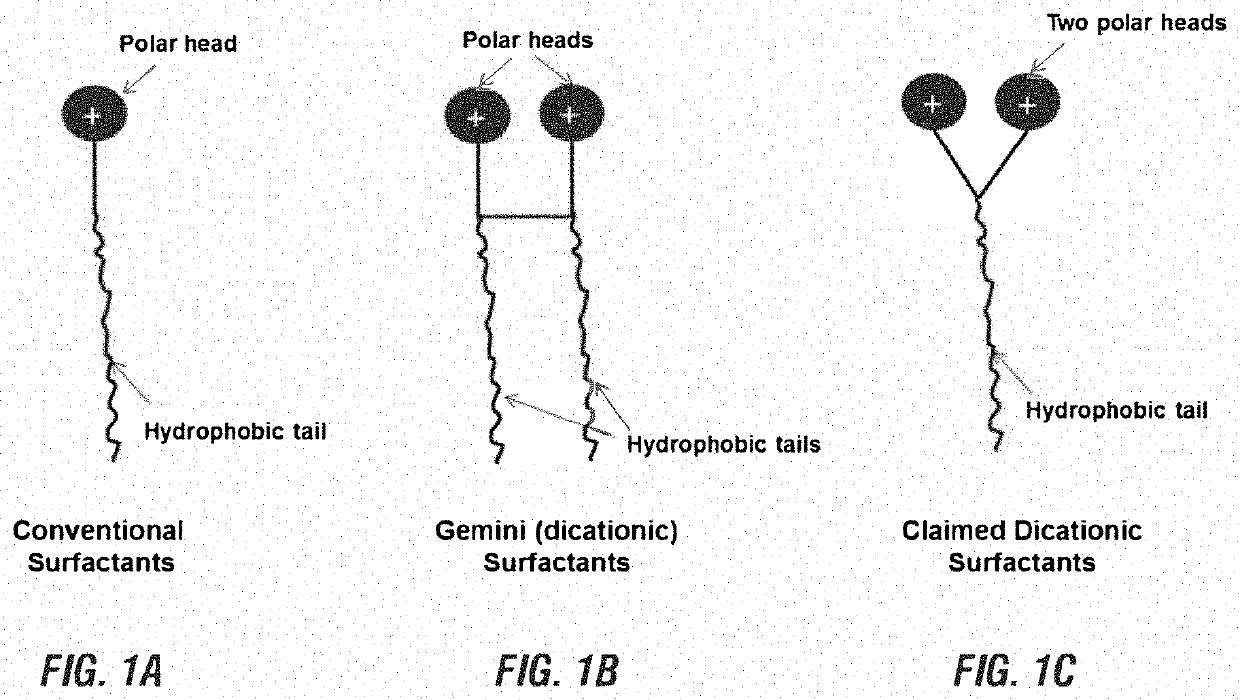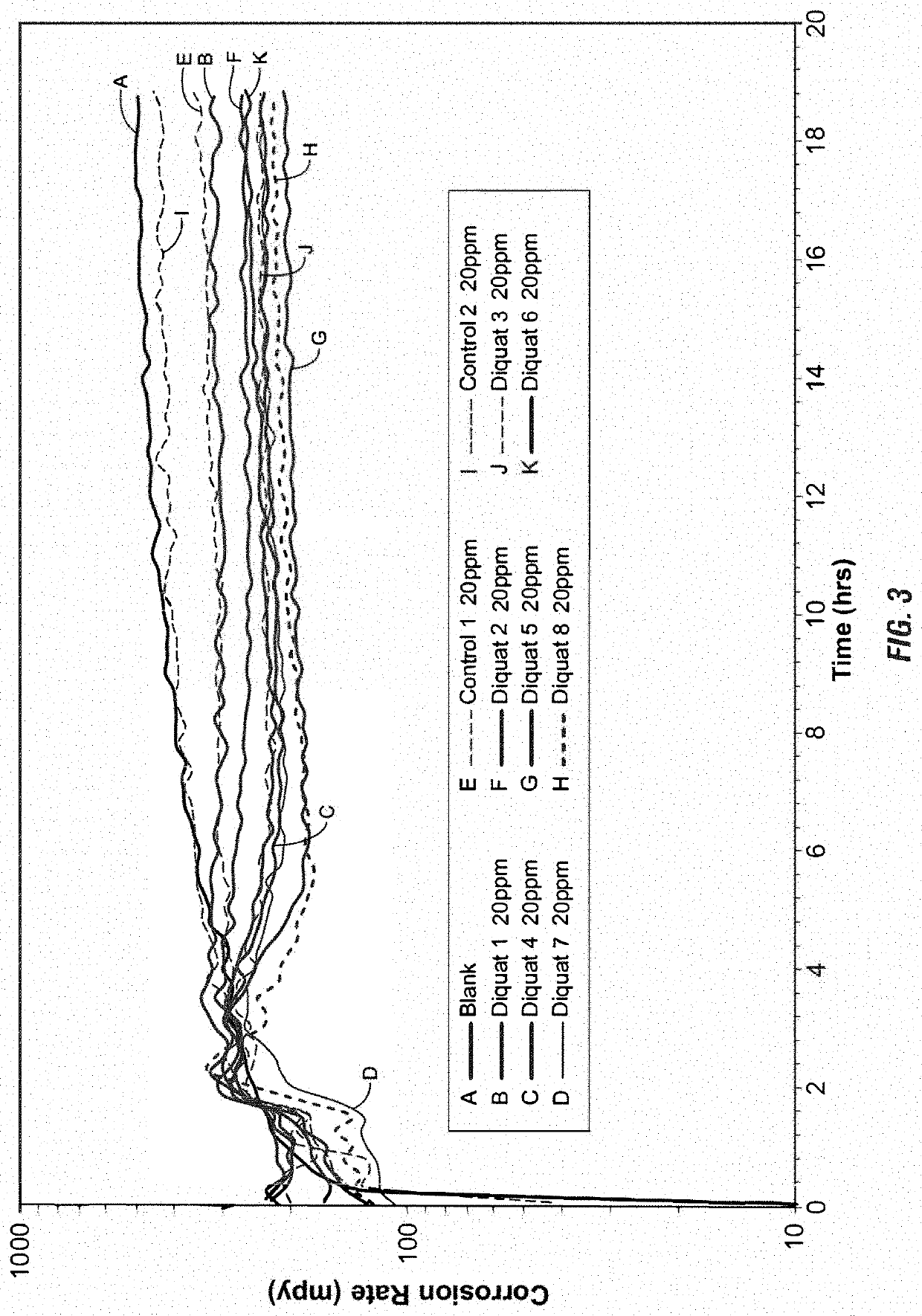Use of di-ionic compounds as corrosion inhibitors in a water system
a technology of diionic compounds and water systems, applied in the direction of water treatment compounds, group 5/15 element organic compounds, detergent compounding agents, etc., can solve the problems of prone to microbial contamination and fouling, metal surfaces in any water system are prone to corrosion, and are known to be very hazardous, and achieve the effect of mitigating corrosion
- Summary
- Abstract
- Description
- Claims
- Application Information
AI Technical Summary
Benefits of technology
Problems solved by technology
Method used
Image
Examples
example 1
[0219]General Scheme to Synthesize Exemplary Compounds Containing Two Quaternary Groups:
[0220]Exemplary di-cationic compounds containing two quat groups as disclosed herein and in Example Section were synthesized, by aza Michael addition reaction between a primary amine (1 mole) and α,β-unsaturated carbonyl compound containing at least one quat group (at least 2 moles). The generic synthesis reaction scheme for preparation of the di-cationic compounds disclosed herein is shown in FIG. 2.
[0221]In FIG. 2, R11 is R1 or R1—Z—(CH2)m—; R1 is an unsubstituted or substituted, linear or branched C5-C30 alkyl, cyclic alkyl, alkenyl, or alkynyl group; Z is NH or O; R2 is H, CH3, or an unsubstituted, linear or branched C2-C10 alkyl, alkenyl, or alkynyl group; m is an integer of 1 to 4; and n is an integer of 1-20.
[0222]The reaction shown in FIG. 2 can be carried out in water at 80° C. The progression of this reaction can be monitored by ESI-MS and / or NMR spectroscopy for consumption of the mono...
example 2
Synthesis of 3,3′-((3,3′-(octylazanediyl)bis(propanoyl))bis(azanediyl))bis(N,N,N-trimethylpropan-1-aminium) chloride (I)
[0223]In this Example, (3-acrylamidopropyl) trimethylammonium chloride (APTAC, 75%, 30 grams, 0.10 mol) was charged into a 250-mL three-necked round bottom flask (RBF) equipped with an overhead stirrer, temperature probe, and condenser. Benzyltrimethylammonium hydroxide (0.9 grams, 10%, 0.0005 mol) and water (41 g) were added into the flask. Octylamine (7 grams, 99%, 0.053 mol) was then added portion wise to the well-stirred reaction mixture. The resulting suspension was stirred at 80° C. overnight. As the reaction proceeded to completion, the suspension turned into a clear yellowish solution. The resulting (˜37 wt %) aqueous solution of the diquat compound was stored in the container. Mass spectrometry (+ESI-MS) confirmed synthesis of the diquat compound I: calc. [M-2Cl−]2+ 235.73, found 235.7241; calc. [M-Cl−]+ 506.42, found 506.4182.
example 3
Synthesis of 3,3′-((3,3′-(dodecylazanediyl)bis(propanoyl))bis(azanediyl))bis(N,N,N-trimethylpropan-1-aminium) chloride (II)
[0224]In this example, (3-acrylamidopropyl) trimethylammonium chloride (APTAC, 75%, 30 grams, 0.10 mol) was charged into a 250-mL three-necked RBF equipped with an overhead stirrer, temperature probe, and condenser. Benzyltrimethylammonium hydroxide (0.9 grams, 10%, 0.0005 mol) and water (63 g) were added into the flask. Dodecylamine (10 grams, 98%, 0.053 mol) was then added portion wise to the well-stirred reaction mixture. The resulting suspension was stirred at 80° C. overnight. As the reaction proceeded to completion, the suspension turned into a clear yellowish solution. The resulting (˜31 wt %) aqueous solution of the diquat compound II was used as is. Mass spectrometry (+ESI-MS) confirmed synthesis of diquat compound II: calc. [M-2Cl−]2+ 263.76, found 263.7554; calc. [M-Cl−]+ 562.48, found 562.4806.
PUM
| Property | Measurement | Unit |
|---|---|---|
| contacting temperature | aaaaa | aaaaa |
| contacting temperature | aaaaa | aaaaa |
| contacting temperature | aaaaa | aaaaa |
Abstract
Description
Claims
Application Information
 Login to View More
Login to View More - R&D
- Intellectual Property
- Life Sciences
- Materials
- Tech Scout
- Unparalleled Data Quality
- Higher Quality Content
- 60% Fewer Hallucinations
Browse by: Latest US Patents, China's latest patents, Technical Efficacy Thesaurus, Application Domain, Technology Topic, Popular Technical Reports.
© 2025 PatSnap. All rights reserved.Legal|Privacy policy|Modern Slavery Act Transparency Statement|Sitemap|About US| Contact US: help@patsnap.com



